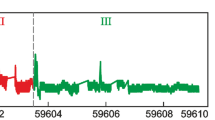The effect of irregularities in the earth’s rotation (precession and nutation of the earth’s axis of rotation, oscillations in the modulus of the angular velocity, periodic deviations in the line of the poles, and the angular momentum of the globe) on the frequency and time of high-stability atomic clocks are examined in terms of the theory of relativity. It is shown that the relative shift in frequency and time owing to these effects can exceed 5·10–16.
Similar content being viewed by others
References
S. I. Donchenko, I. Yu. Blinov, A. S. Goncharov, et al., “State of and prospects for the development of the state primary standard for the unit of time, frequency, and the national time scale GET 1-2012,” Metrology of Time and Space: Proc. 7th Int. Symp., Suzdal (2014), pp. 7–8.
Y. Ovchinnicov and G. Marra, “Accurate rubidium atomic fountain frequency standard,” Metrologia, 48, S87–100 (2011).
V. G. Pal’chikov, “State of and prospects for the development of optical time and frequency standards based on cold atoms and ions,” Fundamental and Applied Coordinate-Time and Navigation Support (KVNO-2011): Proc. 4th All- Russ. Conf., St. Petersburg, 2011, in: Trudy IPA RAN (2012), Iss. 23, pp. 107–111.
C. W. Chou, D. B. Hume, J. C. J. Koelemeij, et al., “Frequency comparison of two high-accuracy Al+ optical clocks,” Phys. Rev. Lett., 104, 070802 (2010).
B. J. Bloom, T. J. Nicholson, J. R. Williams, et al., “An optical lattice clock with accuracy and stability at the 10–18 level,” Nature, 506, 71–75 (2014).
Campbell C. J. et al., “A single-ion nuclear clock for metrology at the 19th decimal place,” Atom. Phys. (physics. atom-ph), http://arxiv.org/abs/1110.2490, accessed Nov. 22, 2014.
L. B. Borisova, K. A. Bronnikov, and V.N. Mel’nikov, “Accounting for relativistic effects when introducing a unified time scale on earth and in near-earth space,” Izmer. Tekhn., No. 5, 31–33 (1988).
P. Wolf and G. Petit, “Relativistic theory for clock syntonisation and the realization of the geocentric coordinate times,” Astron. Astrophys., 304, 653–661 (1995).
J. Hafele and R. Keating, “Around-the-world atomic clocks: predicted relativistic time gains,” Science, 177, 166–168 (1972).
L. B. Borisova and V. N. Mel’nikov, “Relativistic corrections in the readings of portable time standards,” Izmer. Tekhn., No. 4, 13–15 (1988).
G. Petit and P. Wolf, “Relativistic theory for time comparisons: a review,” Metrologia, 42, S138–S144 (2005).
V. F. Fateev and V. P. Sysoev, “Relativistic effects in mobile clocks,” Izmer. Tekhn., No. 8, 31–35 (2014).
S. M. Kopeikin, “Relativistic reference systems in the solar system,” Astron. Zh., 66, No. 5, 1069–1080 (1989).
V. K. Abalakin, E. P. Aksenov, E. A. Grebenikov, et al., Handbook of Celestial Mechanics and Astrodynamics, Nauka, Moscow (1976).
C. Møller, Theory of Relativity [Russian translation], Atomizdat, Moscow (1975).
D. McCarthy and G. Petit, IERS Conventions (2003). IERS Technical Note 32, Verlag des Bundesamts für Kartographie und Geodäsie, Frankfurt am Main (2004).
“Universal time and the coordinates of the poles,” Byull. E GSVCh (2013), No. 153–156, p. 6.
G. Petit and B. Luzum, IERS Conventions (2010). IERS Technical Note 36, Verlag des Bundesamts für Kartographie und Geodäsie, Frankfurt am Main (2010).
This work was done as part of the experimental and design project on Creation of a National Geocentric Coordinate System (GGSK-tochnost) and was supported by the Russian Science Foundation (Grant 14-27-00068).
Author information
Authors and Affiliations
Corresponding author
Additional information
Translated from Izmeritel’naya Tekhnika, No. 6, pp. 41–45, June, 2015.
Rights and permissions
About this article
Cite this article
Fateev, V.F., Kopeikin, S.M. & Pasynok, S.L. Effect of Irregularities in the Earth’s Rotation on Relativistic Shifts in Frequency and Time of Earthbound Atomic Clocks. Meas Tech 58, 647–654 (2015). https://doi.org/10.1007/s11018-015-0769-0
Received:
Published:
Issue Date:
DOI: https://doi.org/10.1007/s11018-015-0769-0




